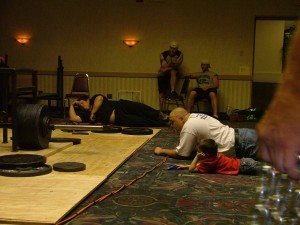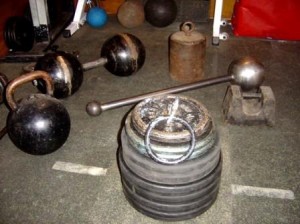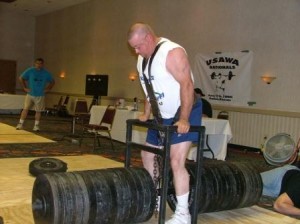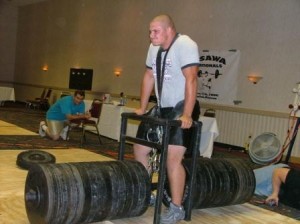by Thom Van Vleck

Thom Van Vleck getting "Down and Dirty" to judge the Harness Lift with a helper!
My own story on the Harness lift goes like this. After that 2006 USAWA Nationals mentioned in part 1: Harness Lift, I got one of the harnesses and heavy bars Al made special for that meet. I brought it home but did not have enough weight to load it! So I contacted my good friend, Bob McConaughey with the BNSF railroad and he set me up with a pair of railroad car wheels. I thought the RR car wheels would be cool to lift and we could also use them in our strongman evangelism shows. I’ll never forget our conversation when he asked me what size I wanted:
Thom: “So, what size do you have?”
Bob: “Well, they can range from 1000lbs and up to 4000lb”
Thom: “Apeice!!!!……uhhh…what’s the smallest you can get me?”
Bob (laughing): “I think we could find you some coal car wheels that are in the 800lb range!”
So, it was off to Galesburg, Illinois to pick up some surplus steel! I took my half ton truck to pick up a ton and a half of steel. John O’Brien went along for the ride and upon arriving, the trainmaster took us down to the yard to get them loaded. They were on a palate and I’ll never forget when the trainmaster asked the loading dock guy for help loading them and the loader looked at the wheels and at us and said, “Don’t you think a fork lift would be easier”!? As he walked off to get the fork lift, the trainmaster mutter under his breath a more crude version of “NO CRAP”!!! My poor pick up has hauled a lot of crazy stuff over the years, but you should have seen the it sink under that weight!
I got them home, and realized as I got them into my gym that these things were so heavy they were actually extremely dangerous, if they tipped over they could sever whatever was under them. But, I got them modified and loaded on to my heavy bar. My Dad had come over and helped me slip the harness on and I made my adjustments. Finally, I had them adjusted and with an estimated 1700lbs, I began to pull….an pull….and pull. It was then I realized that when you do Heavy Lifts, you have to have a whole new mindset! Upon proper mental approach which involves pain tolerance and the feeling that something is going to rip in any given joint in your body, I lifted it. I then loaded it to an estimated 2000lbs and after a couple of attempts, got that, too. I was elated!!! Later, I took my shirt off to shower and looked in the mirror and realize I had blood blisters all over my shoulders and hips. I looked like I had been bull whipped! The next day I felt some serious joint and muscle soreness, but a lasting satisfaction that I had “lifted a ton”!
If you want to get started in Harness Lifting, my recommendation is you need to work into it slower than I did and get some coaching by someone that knows what they are doing….it will save you some time and maybe injuries! Since you aren’t going to buy a harness or Heavy Bar at the local sporting goods store, I would take a good look at a Harness before making one and ask guys who have them how they made them. They have made all the mistakes for you and can tell you the best way to go about it.
Finally, you are always welcome to stop by the JWC Training Hall and give the Harness lift a shot!



